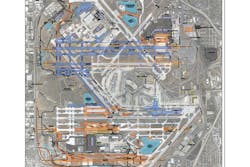ORD-area Residents' Bid To Stop Runway Expansion, Noise Falls On Deaf Ears
Sept. 06--Thousands of Chicago-area residents have been dealt a setback in their hopes to thwart an O'Hare International Airport runway expansion that, starting next month, is set to bring more jet noise to their neighborhoods.
With a new O'Hare runway set to open Oct. 17, many residents and community groups under O'Hare flight paths have in recent months appealed to U.S. Rep. Mike Quigley, a Democratic representative whose district includes the North Side and suburbs near the airport, to persuade the Federal Aviation Administration and the Emanuel administration to reduce the noise's impact by altering air-traffic patterns.
On the heels of a closed-door meeting Tuesday that included a coalition of concerned residents and FAA and Chicago aviation officials, Quigley said Thursday that the runway-redesign project at O'Hare is vital to the entire region.
"A lot of folks are going to have less noise and a lot of folks are going to have more noise because the airport expansion and the reconfiguration of the runways mean more flights, more growth, more economic drive for the region," he said. "That was something planned a long time ago. It makes sense for the airport. My job is to keep the expansion going forward, but to mitigate the environmental cost, the noise cost, to my constituents.".
His meeting included representatives from FAiR Allocation in Runways, which is seeking to stop the change in runway patterns and instead have O'Hare controllers continue the same level of use of two diagonal runways that channel jet noise to the northwest suburbs.
The opening of a new runway next month will mark a major shift to predominantly east and west departure and arrival flows. Areas to the north and south of O'Hare are projected to experience less noise, while more areas to the east and west of the airfield are expected to get more.
When the O'Hare Modernization Program is completed, the airport will have six east-west runways and two diagonal runways. The diagonals would be used sparingly, based on crosswind conditions, according to the FAA.
The best that noise-weary residents can hope for is more ground-based noise-monitoring devices; a lowering of the average-noise threshold (from 65 decibels) that qualifies homeowners for government-funded soundproofing; and tighter adherence to voluntary "fly quiet'' guidelines, in which pilots point jet noise away from populated areas to the greatest degree possible, Quigley said.
Quigley pledged to move those initiatives forward "so that some neighbors aren't just totally hammered with the expansion. To the extent all that's possible is where we are going.''
He said it helps that American Airlines will be phasing out its MD-80 aircraft, which Quigley called "really loud older planes.'' But the airline will continue to operate the MD-80s until about 2020, American spokeswoman Mary Frances Fagan said.
Judie Simpson, who lives in the 39th Ward under an O'Hare flight corridor and who is a member of the FAiR coalition, said the group met again with Quigley on Thursday morning and remains somewhat hopeful.
"He has not signed on to say he is committed to make changes,'' Simpson said. "But I feel he has heard us, he is concerned about us and he is willing to work for some compromises.''
"Overwhelmingly we got the sense that the FAA and city do not want to make any changes,'' Simpson said about the meeting Tuesday.
She said the city and the FAA have not provided the public with complete information on planned nighttime flights and total flights envisioned for the airport.
"We feel the planes are already flying lower and we know they are louder," Simpson said, adding "there are no noise monitors over our area," which is about 10 miles east of O'Hare.
Twitter @jhilkevitch
Copyright 2013 - Chicago Tribune
